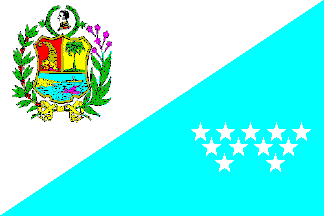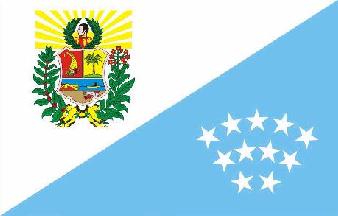 (2:3)
image by Pascal Gross, 1 October 2001
(2:3)
image by Pascal Gross, 1 October 2001
Last modified: 2024-02-24 by rob raeside
Keywords: sucre | venezuela |
Links: FOTW homepage |
search |
disclaimer and copyright |
write us |
mirrors
 (2:3)
image by Pascal Gross, 1 October 2001
(2:3)
image by Pascal Gross, 1 October 2001
 (2:3)
image by Pascal Gross, 1 October 2001
(2:3)
image by Pascal Gross, 1 October 2001
See also:
Municipalities (Capitals):
Other localities
Sucre State Flag is the oldest in Venezuela . In its time,
when Venezuela was heavily centralised, it caused some stir.
Still, it has remained not only as a very characteristic flag,
but also as a beautifully designed one (although it's hard to see
when flown). A two-colour field (white, light-blue; these divided
diagonally), serve as bed for the State's badge on the white half
(upper, lying on the hoist side); and for eleven, white,
five-pointed stars (one for each of the State's
municipalities; their number changes accordingly).
White is the colour of purity and nobility, as well as the
reflection of Sucre's white sands and production of salt.
Light-blue stands for bravery and generosity, as well as for the
pristine and clear waters of its sea.
Guillermo Aveledo, 3 October 1999
Concering Guillermo Aveledo image of the Sucre State
flag , it should be moted that some other flags of
this state were published in my Bulletin (issue 2) , but they
were not too good images. later I made six more accurate images
of these flags.
Good source for this flag is "Los simbolos del estado de
Sucre" by Oscar Prieto Ruiz (Rio Caribe 1984)
According Gaceta de banderas (1989) the flag has 14 stars; in W.
Smith (1975) the flag has 10 stars. The image from Guillermo
has 11 stars so it must be from around c. 1980.
Jaume Ollé, 3 Novemner 1999
Since the number of municipios is very fluctuating, I merely
rounded up an average of the different versions I had . I assume
that the number may vary, and that they actually might change in
the near future.
Guillermo Aveledo, 4 Novemner 1999
Has the number of stars on the flag of Sucre (Venezuela)
changed again?
I think that the answer is yes if we look at the following page
<www.estadosucre.com>.
In the accompanying text, it is said that the number of stars
depends on the number of districts (today municipalities) which
belong to the state. At <www.estadosucre.com/geografia.htm>,
it is said that the number of political divisions is now 15
municipalities (Andre's Eloy Blanco, Andre's Mata, Arismendi,
Beni'tez, Bermu'dez, Boli'var, Cajigal, Cruz Salmero'n Acosta,
Libertador, Marin~o, Meji'a, Montes , Ribero, Sucre,Valde'z) so
there's some good reason for the number of stars to be now 15.
There are two versions of this flag at the following URL's (one
with Coat of Arms and one without it).
Pascal Gross, 1 October 2001
Sucre's flag was the first State flag made official in
Venezuela: created by Mr. Oscar Prieto Ruíz and approved on
November 24th, 1965 by the Legislative Assembly by means of the
Law of Flag, Shield and Hymn of Sucre State, it was ratified by
the Legislative Assembly and hoisted for the first time on
February 3rd, 1996.
Raul Orta, 2 December 2004
Eleven stars had the first Sucre State flag which was adopted
on the November 24, 1965. The current flag of Sucre State has 15
stars. Every star presented a municipality. Which municipalities
were created after 1965? Which year were the new municipalities
created? Did variants of the Sucre State flag with 12, 13 or 14
stars also exist? When was the current flag with 15 stars
adopted?
Jens Pattke, 15 March 2005
The flag of Sucre state with 15 Stars seems was adopted on
2002 but this data is subject to confirmation.
Raul Orta, 16 March 2005

image by Guillermo Aveledo, 3 October 1999

image from <www.lacasadelasbanderas.com>
Sucre state flag in <www.lacasadelasbanderas.com>
is differ in the stars combination and the CoA from the above
flag.
Dov Gutterman, 24 june 2001
At Venezuelan pages in Smith 1982 [smi82]
only one flag for subnational entities is given, that of the
Sucre state. There is shown the 11 stars version in ratio 3:4~
(we show flags mostly in 2:3 ratio for Sucre). The version in
Smith is very similar to one posted from <www.lacasadelasbanderas.com>,
minor differences being the darker blue used (practically the
same blue as in the national flag) and very minor difference in
stars arrangement.
At Crampton's [cra90f]: State
of Sucre - diagonally white over blue with the arms in the canton
and 10 white stars in the fly (endquote). Sucre flag is basically
as in [smi82] - but Smith has 11
stars already in 1975, and also in 1982. Did Sucre decreased the
number of municipalities since and afterwards increased them up
to 15 used today?
Željko Heimer, 29 August 2003
r.gif)
image by Guillermo Aveledo, 3 October 1999
According to 1981 edition of "Los Simbolos Sagrados de la
Nacion Venezolana", by Francisco A. Vargas: "Sucre Coat
of Arms dates from 1910. Sucre's Coat of Arms measures (according
to the rules on it) 60 cm high and 47 wide. It exhibits a field
divided in three quarters. The upper-left one, red or burgundy
(it's, how strange, not specified: I've seen it both ways!!) a
golden inverted cornucopia appears, as emblem of abundance,
flowing out of its realms rich and varied fruits. Inside the
upper-right one, on limpid yellow, evocative of the prosperity
and happy destinies of the region, a cocotero (coconut tree)
rises, fruity and lone, representing one of the State's main
crops. The ample lower quarter, light blue, concentrates a wide
range of symbols: the pale blue of the heavens, the amplitude of
the seas, flowing calmly beyond the horizon. The golden coast
exposes itself, breaking its lines to the right where we can see
small hills and dunes; to the left, a fisherman and fish can be
seen, symbolising, what else, the fishing trade. Below the field,
centered, a yellow band ties two twigs, one of blossomed
tobacco (right), and the other of ripe coffee (left). Above the
field, a laurel crown sits: inside this crown, amid sunrays (not
shown; they are used alternatively) the victorious profile of the
Great Mariscal of Ayacucho, General Sucre, can be admired."
Guillermo Aveledo, 3 October 1999